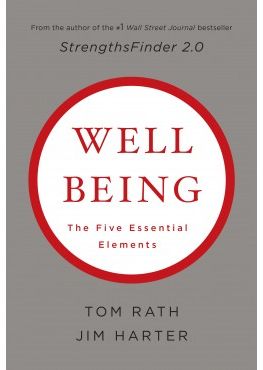 A while back I was given a copy of the book Wellbeing – The Five Essential Elements by Tom Rath and Jim Harter. In this book Rath and Harter look at the five essential elements that shape our lives: Career Wellbeing, Financial Wellbeing, Physical Wellbeing, Social Wellbeing and Community Wellbeing.
A while back I was given a copy of the book Wellbeing – The Five Essential Elements by Tom Rath and Jim Harter. In this book Rath and Harter look at the five essential elements that shape our lives: Career Wellbeing, Financial Wellbeing, Physical Wellbeing, Social Wellbeing and Community Wellbeing.
In the introduction to the book the authors say “Wellbeing is about the combination of our love for what we do each day, the quality of our relationships, the security of our finances, the vibrancy of our physical health, and the pride we take in what we have contributed to our communities.”
For today’s post I am going to go into more detail about Financial Wellbeing.
Financial Wellbeing is about effectively managing your economic life. The authors note that it is difficult to be happy in any area of life if you cannot meet your basic needs (remember Maslow’s Hierarchy of Needs?), but that the amount of money we have, beyond a certain point, has less of an impact on our overall wellbeing than the concepts of “financial security” and effectively managing our finances.
“People with high Financial Wellbeing manage their personal finances well and spend their money wisely. They buy experiences instead of just material possessions, and they give to others instead of always spending on themselves. At a basic level, they are satisfied with their overall standard of living.” (Rath & Harter, 2010, p 154).
There are several important concepts in that statement. People with high Financial Wellbeing:
- Manage their personal finances well
- Spend their money wisely
- Buy experiences instead of just material possessions
- Give to others
- Are satisfied with their overall standard of living
Let’s discuss a few of those concepts.
Give to Others
The authors cite three studies that show that spending money on yourself may temporarily make you feel good, but after time that good feeling fades. While spending money on yourself does not boost wellbeing, spending money on others does. When we help others out we feel good, even if it is just a little bit of money. For more detail on this subject, see “Why Giving Matters” (https://ryanhlaw.com/why-giving-matters/).
Buy Experiences
While spending on material goods doesn’t increase wellbeing long-term, spending on experiences does. Think about some of the material items you purchased over the past year, and then think about some of the experiences you purchased in the last year. Experiences can include trips or something as simple as going out to a nice dinner or going to a movie. Do the material items or experiences give you the most happiness? Most people would agree that experiences give them the most happiness. Things that come to mind for me are date nights with my wife, going to a movie as a family, and taking a trip over Spring Break. With experiences we get to look forward to the event, enjoy the event and have fond memories of it. It is interesting to note that for those that earn less than $25,000 per year experiences and material purchases show similar gains in wellbeing, but after $25,000 experiences provide two to three times the levels of wellbeing when compared to material purchases.
Manage Personal Finances Well
This concept brings us back to many of the things I have covered in this blog; budgeting, protecting yourself from identity theft, having a basic estate plan in place, saving for emergencies, investing for the future, etc. The authors also suggest you establish default systems, such as direct deposit, automatic deduction for investments and enrolling in your 401(k) at work so savings is automatic.
It is important to remember that all areas of Wellbeing (career, financial, physical, social, and community) work together. You can’t just focus on one area and ignore the others.
I recommend you read the book to see how you can improve your life in all five areas. http://www.amazon.com/Wellbeing-The-Five-Essential-Elements/dp/1595620400


Leave a Reply